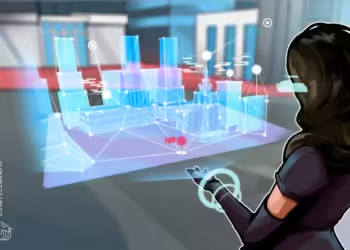Mapping on the Blockchain: A Comprehensive Guide. The global positioning system (GPS) calculates a person’s location, blends it with their environment, and presents it live on their mobile device via a real-time interface. Blockchain-based methods make it transparent and immune to intervention. Using GPS-based navigation systems has become ubiquitous. People use tools such as Google Maps, OpenStreetMap and Foursquare, which rely on GPS. However, these services are hampered by a common problem – centralization — which makes them prone to opaque functioning and a central point of failure when it comes to hacking.
Blockchain technology offers various advantages over centralized systems and helps users tide over the limits of traditional technologies like GPS mapping. It promotes openness, boosts resilience to hacking attempts and enables faster data processing. Unsurprisingly, some firms have begun to use it.
Inefficiencies in Current Interactive Maps
Despite being in use for almost ten years, the current interactive map system based on GPS still has certain shortcomings. On occasion, the data from these systems could load slowly and be erroneous. Large volumes of data must be processed and stored for GPS mapping, typically on centralized servers. This could lead to delays in sharing and accessing the data. These technologies put user privacy at risk because they track a person’s whereabouts in real time. For corporations, the cost of developing and maintaining a traditional GPS system may also be prohibitive.
Because of the quick pace of development, centralized mapping is dependent on proprietary data that may be out of date and may not accurately reflect recent advancements in roads, highways, and infrastructure. Moreover, GPS has trouble accurately charting crowded cities. The mapping supplier must put in a lot of effort to thoroughly record every area when creating interactive maps in areas with small lanes, which is expensive and time-consuming. Furthermore, GPS lacks facilities for authentication or proof-of-origin in civil applications like surveying and transportation, and it is vulnerable to spoofing, jamming, and cyberattacks.
Crowdsourcing is used by most mapping initiatives to facilitate their operations. For example, many volunteers to OpenStreetMap update map data using low-tech field maps, GPS devices, and aerial photos. As we move closer to the Internet of Things (IoT), new applications for crowdsourcing will probably appear. But issues that crowdsourcing projects have typically faced, like accuracy issues and top-down policy implementation, might be widespread. Mapping based on blockchain offers a workable substitute.
How Blockchain Augments Interactive Digital Maps

The decentralized architecture that underpins blockchain technology may offer practical solutions to problems that are frequently encountered with conventional interactive digital maps. GPS mapping requires processing and storing large amounts of data on one or more servers. Because GPS mapping is centralized, managing massive volumes of data on constrained computers can cause delays in processing and transmission. On the other hand, decentralized apps (DApps) spread data among a number of network devices, or nodes, which lowers latency and facilitates seamless data access.
These applications can maintain more accurate and up-to-date location data because they rely on a decentralized network of nodes rather than a single centralized authority to continuously authenticate transactions and data updates. The consensus mechanism of the blockchain maintains data integrity and guards against unauthorized changes by requiring confirmation from many nodes before accepting changes.
Greater privacy is a further advantage of using blockchain for mapping. Conventional GPS mapping forces people to provide location data to large corporations so they can profit from this geotagged data without obtaining their permission. However, Blockchain works without a single, central authority that can decide anything unanimously. Instead, data is distributed among several nodes, enhancing user privacy.
Can Blockchains be Used for Spatial Verification?
Spatial verification in blockchain is the process of validating the physical location of an event, object or user within a decentralized network. Spatial verification refers to the confirmation that items are in the place where they claim to be. It is particularly valuable in numerous industries, especially supply chain management.
For instance, when an Amazon delivery drone drops off a product at an owner’s door, the cost is charged to the owner’s account, relying on geographical verification. This eliminates problems with dishonest delivery workers and arguments over charges for things that go missing. Similarly, if someone has a damaged windshield, they can utilize blockchain-based spatial verification to back up their insurance claim by sharing a photo and documents showing the time and location.
What is Proof-of-location Protocol?

PoL ensures the veracity of a user’s location data without depending on a single authority by combining consensus methods and cryptographic algorithms. Proof of location (PoL) in blockchain refers to verifying a user’s actual location in a decentralized network. PoL ensures the accuracy of location-based services and transactions across a variety of applications, such as asset tracking, decentralized banking, supply chain management, and more.
Using a network of reliable nodes, or oracles, to gather and verify position data from a variety of sources, such as GPS satellites, WiFi signals, and mobile phone towers, is a common method of implementing PoL. Then, by broadcasting signed messages or proofs to the blockchain, these nodes confirm the user’s location.
Mapping on the Blockchain: Users may securely interact with location-aware smart contracts and DApps while upholding their privacy and confidence by integrating PoL into blockchain systems. This technology opens up new applications for location-based services and facilitates creative use cases requiring blockchain-based location data that can be independently verified.
Core Clements of a PoL Smart Contract
Location data submissions, verification mechanisms, data storage, and linking spatial verification to specific actions are the core elements of a PoL smart contract.
Location data submission
The smart contract would define how users or devices submit location data, including:
- Geotagged photos or videos.
- GPS coordinates from a mobile device.
- Sensor readings from IoT devices confirming a location.
Verification mechanisms
The contract would need ways to verify the submitted location:
- Using reputation systems to assess the reliability of data providers.
- Cross-checking with multiple data sources.
- Employing cryptographic techniques to prevent location spoofing.
Data storage
A tamper-proof record would be created by securely storing the verified location data on the blockchain.
Triggering actions
The smart contract would link the location verification to specific actions, such clearing insurance claims, paying out in supply chain scenarios, or allowing access based on physical presence verification.
Limitations of a Proof-of-location Protocol
Despite its promise, PoL isn’t without its flaws. Examples include overreliance on third-party data sources, scalability issues, and inconsistent regional applicability. Although PoL has its benefits, it does have some major drawbacks as well. Concerns arise by the frequent use of external data sources because it makes spoofing and manipulation possible. Because verifying location data for many transactions requires substantial processing resources, PoL may also encounter scalability issues.
Since PoL solutions aren’t always applicable, verification accuracy may vary by location or circumstance. Incorporating physical addresses, coordinates, or geographic locations into smart contracts is not yet standardized. Different hardware architectures, protocols, and business strategies characterize each platform that is currently in development. For PoL to be widely used and effective in blockchain applications, these limitations must be removed.


















